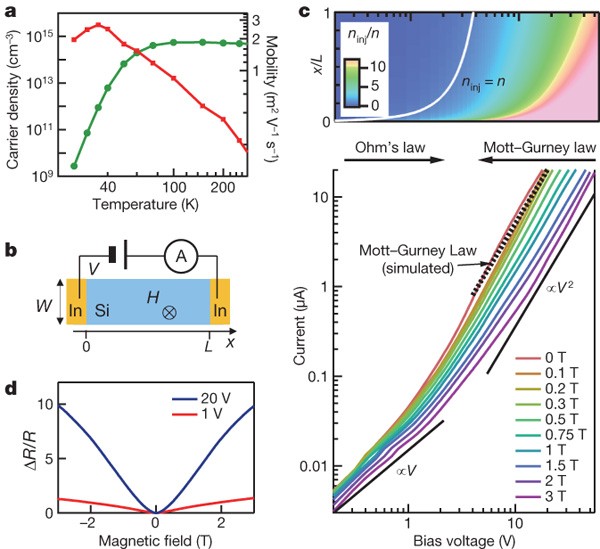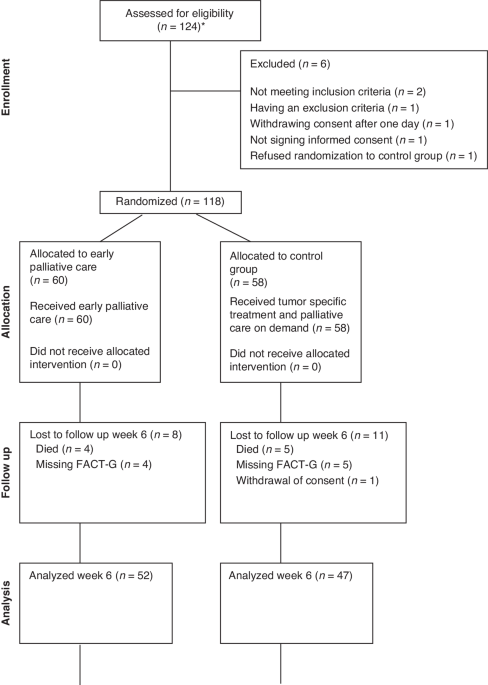
- Select a language for the TTS:
- UK English Female
- UK English Male
- US English Female
- US English Male
- Australian Female
- Australian Male
- Language selected: (auto detect) - EN
Play all audios:
ABSTRACT Recent discoveries of large magnetoresistance in non-magnetic semiconductors1,2,3,4,5,6,7,8 have gained much attention because the size of the effect is comparable to, or even
larger than, that of magnetoresistance in magnetic systems9,10,11,12,13,14. Conventional magnetoresistance in doped semiconductors is straightforwardly explained as the effect of the Lorentz
force on the carrier motion15, but the reported unusually large effects imply that the underlying mechanisms have not yet been fully explored. Here we report that a simple device, based on
a lightly doped silicon substrate between two metallic contacts, shows a large positive magnetoresistance of more than 1,000 per cent at room temperature (300 K) and 10,000 per cent at 25 K,
for magnetic fields between 0 and 3 T. A high electric field is applied to the device, so that conduction is space-charge limited16,17,18. For substrates with a charge carrier density below
∼1013 cm-3, the magnetoresistance exhibits a linear dependence on the magnetic field between 3 and 9 T. We propose that the observed large magnetoresistance can be explained by
quasi-neutrality breaking of the space-charge effect, where insufficient charge is present to compensate the electrons injected into the device. This introduces an electric field
inhomogeneity, analogous to the situation in other semiconductors in which a large, non-saturating magnetoresistance was observed1,2,3,4,5,19. In this regime, the motions of electrons become
correlated, and thus become dependent on magnetic field. Although large positive magnetoresistance at room temperature has been achieved in metal–semiconductor hybrid devices6,7,8, we have
now realized it in a simpler structure and in a way different from other known magnetoresistive effects9,10,11,12,13,14,20. It could be used to develop new magnetic devices from silicon,
which may further advance silicon technology. Access through your institution Buy or subscribe This is a preview of subscription content, access via your institution ACCESS OPTIONS Access
through your institution Subscribe to this journal Receive 51 print issues and online access $199.00 per year only $3.90 per issue Learn more Buy this article * Purchase on SpringerLink *
Instant access to full article PDF Buy now Prices may be subject to local taxes which are calculated during checkout ADDITIONAL ACCESS OPTIONS: * Log in * Learn about institutional
subscriptions * Read our FAQs * Contact customer support SIMILAR CONTENT BEING VIEWED BY OTHERS MAGNETORESISTIVE-COUPLED TRANSISTOR USING THE WEYL SEMIMETAL NBP Article Open access 24
January 2024 PHONON-LIMITED MOBILITY FOR ELECTRONS AND HOLES IN HIGHLY-STRAINED SILICON Article Open access 12 October 2024 CONDUCTIVITY AND SIZE QUANTIZATION EFFECTS IN SEMICONDUCTOR
\(\DELTA\)-LAYER SYSTEMS Article Open access 30 September 2022 REFERENCES * Xu, R. et al. Large magnetoresistance in non-magnetic silver chalcogenides. _Nature_ 390, 57–60 (1997) Article
CAS Google Scholar * Husmann, A. et al. Megagauss sensors. _Nature_ 417, 421–424 (2002) Article CAS Google Scholar * Parish, M. M. & Littlewood, P. B. Non-saturating
magnetoresistance in heavily disordered semiconductors. _Nature_ 426, 162–165 (2003) Article CAS Google Scholar * Parish, M. M. & Littlewood, P. B. Classical magnetotransport of
inhomogeneous conductors. _Phys. Rev. B_ 72, 094417 (2005) Article Google Scholar * Zhang, T. et al. Tuning the inherent magnetoresistance of InSb thin films. _Appl. Phys. Lett._ 88,
012110 (2006) Article Google Scholar * Solin, S. A., Thio, T., Hines, D. R. & Heremans, J. J. Enhanced room-temperature geometric magnetoresistance in inhomogeneous narrow-gap
semiconductor. _Science_ 289, 1530–1532 (2000) Article CAS Google Scholar * Moussa, J. et al. Finite-element modelling of extraordinary magnetoresistance in thin film semiconductors with
metallic inclusions. _Phys. Rev. B_ 64, 184410 (2001) Article Google Scholar * Solin, S. A. et al. Nonmagnetic semiconductors as read-head sensors for ultra-high-density magnetic
recording. _Appl. Phys. Lett._ 80, 4012–4014 (2002) Article CAS Google Scholar * Baibich, M. N. et al. Giant magnetoresistance of Fe(001)/(001) Cr magnetic superlattices. _Phys. Rev.
Lett._ 61, 2472–2475 (1988) Article CAS Google Scholar * Berkowitz, A. E. et al. Giant magnetoresistance in heterogeneous Cu-Co alloys. _Phys. Rev. Lett._ 68, 3745–3748 (1992) Article
CAS Google Scholar * Xiao, J. Q., Jiang, J. & Chien, C. L. Giant magnetoresistance in nonmultilayer magnetic systems. _Phys. Rev. Lett._ 68, 3749–3752 (1992) Article CAS Google
Scholar * Jin, S. et al. Thousandfold change in resistivity in magnetoresistive La-Ca-Mn-O films. _Science_ 264, 413–415 (1994) Article CAS Google Scholar * Yuasa, S. et al. Giant
room-temperature magnetoresistance in single-crystal Fe/MgO/Fe magnetic tunnel junctions. _Nature Mater._ 3, 868–871 (2004) Article CAS Google Scholar * Parkin, S. S. P. et al. Giant
tunnelling magnetoresistance at room temperature with MgO (100) tunnel barriers. _Nature Mater._ 3, 862–867 (2004) Article CAS Google Scholar * Ashcroft, N. W. & Mermin, N. D. _Solid
State Physics_ (Holt, Rinehart and Winston, 1976) MATH Google Scholar * Sze, S. M. & Ng, K. K. _Physics of Semiconductor Devices_ 3rd edn (Wiley, 2007) Google Scholar * Rose, A.
Space-charge-limited currents in solids. _Phys. Rev._ 97, 1538–1544 (1955) Article CAS Google Scholar * Lampert, M. A. Simplified theory of space-charge-limited currents in an insulator
with traps. _Phys. Rev._ 103, 1648–1656 (1956) Article CAS Google Scholar * Herring, C. Effect of random inhomogeneities on electrical and galvanomagnetic measurements. _J. Appl. Phys._
31, 1939–1953 (1960) Article Google Scholar * Sun, Z. G., Mizuguchi, M., Manago, T. & Akinaga, H. Magnetic-field-controllable avalanche breakdown and giant magnetoresistive effects in
Gold/semi-insulating GaAs Schottky diode. _Appl. Phys. Lett._ 85, 5643–5645 (2004) Article CAS Google Scholar * Payling, C. A. et al. Electric field-induced quasi-elastic inter-Landau
level scattering in the space-charge-limited magnetoconductivity of n+n-n+ InP structures. _Superlatt. Microstruct._ 2, 415–419 (1986) Article CAS Google Scholar * Yafet, Y., Keyes, R. W.
& Adams, E. N. Hydrogen atom in a strong magnetic field. _J. Phys. Chem. Solids_ 1, 137–142 (1956) Article Google Scholar * Sladek, R. J. Magnetically induced impurity banding in
n-InSb. _J. Phys. Chem. Solids_ 5, 157–170 (1958) Article CAS Google Scholar * Shklovskii, B. I. & Efros, A. L. _Electronic Properties of Doped Semiconductors_ (Springer, 1984) Book
Google Scholar * Sampsell, J. B. & Garland, J. C. Current distortion effects and linear magnetoresistance of inclusions in free-electron metals. _Phys. Rev. B_ 13, 583–589 (1976)
Article CAS Google Scholar * Stroud, D. & Pan, F. P. Effect of isolated inhomogeneities on the galvanomagnetic properties of solids. _Phys. Rev. B_ 13, 1434–1438 (1976) Article CAS
Google Scholar * Bergman, D. J. & Stroud, D. G. High-field magnetotransport in composite conductors: Effective medium approximation. _Phys. Rev. B_ 62, 6603–6613 (2000) Article CAS
Google Scholar * Tornow, M., Weiss, D., v, Klitzing, K. & Eberl, K. Anisotropic magnetoresistance of a classical antidot array. _Phys. Rev. Lett._ 77, 147–150 (1996) Article CAS
Google Scholar * Lampert, M. A. & Rose, A. Volume-controlled, two-carrier currents in solids: The injected plasma case. _Phys. Rev._ 121, 26–37 (1961) Article Google Scholar *
Schoonus, J. J. H. M., Bloom, F. L., Wagemans, W., Swagten, H. J. M. & Koopmans, B. Extremely large magnetoresistance in boron-doped silicon. _Phys. Rev. Lett._ 100, 127202 (2008)
Article CAS Google Scholar Download references ACKNOWLEDGEMENTS We appreciate discussions with T. Shinjo, H. Akinaga, H. Sakakima, Y. Iye, J. Ohe, S. Takahashi and T. Susaki. This work
was partly supported by KAKENHI, ICR Grants for Young Scientists, the Asahi Glass Foundation and the Sumitomo Foundation. M.P.D. acknowledges support from JSPS Research Fellowships for Young
Scientists. AUTHOR INFORMATION AUTHORS AND AFFILIATIONS * Institute for Chemical Research,, Michael P. Delmo, Shinya Kasai, Teruo Ono & Kensuke Kobayashi * Institute for Integrated
Cell-Material Sciences, Kyoto University, Uji 611-0011, Japan , Shinpei Yamamoto Authors * Michael P. Delmo View author publications You can also search for this author inPubMed Google
Scholar * Shinpei Yamamoto View author publications You can also search for this author inPubMed Google Scholar * Shinya Kasai View author publications You can also search for this author
inPubMed Google Scholar * Teruo Ono View author publications You can also search for this author inPubMed Google Scholar * Kensuke Kobayashi View author publications You can also search for
this author inPubMed Google Scholar CORRESPONDING AUTHOR Correspondence to Kensuke Kobayashi. SUPPLEMENTARY INFORMATION SUPPLEMENTARY FIGURES This file contains Supplementary Figures S1-S4
with Legends (PDF 618 kb) POWERPOINT SLIDES POWERPOINT SLIDE FOR FIG. 1 POWERPOINT SLIDE FOR FIG. 2 POWERPOINT SLIDE FOR FIG. 3 POWERPOINT SLIDE FOR FIG. 4 RIGHTS AND PERMISSIONS Reprints
and permissions ABOUT THIS ARTICLE CITE THIS ARTICLE Delmo, M., Yamamoto, S., Kasai, S. _et al._ Large positive magnetoresistive effect in silicon induced by the space-charge effect.
_Nature_ 457, 1112–1115 (2009). https://doi.org/10.1038/nature07711 Download citation * Received: 03 June 2008 * Accepted: 08 December 2008 * Issue Date: 26 February 2009 * DOI:
https://doi.org/10.1038/nature07711 SHARE THIS ARTICLE Anyone you share the following link with will be able to read this content: Get shareable link Sorry, a shareable link is not currently
available for this article. Copy to clipboard Provided by the Springer Nature SharedIt content-sharing initiative
